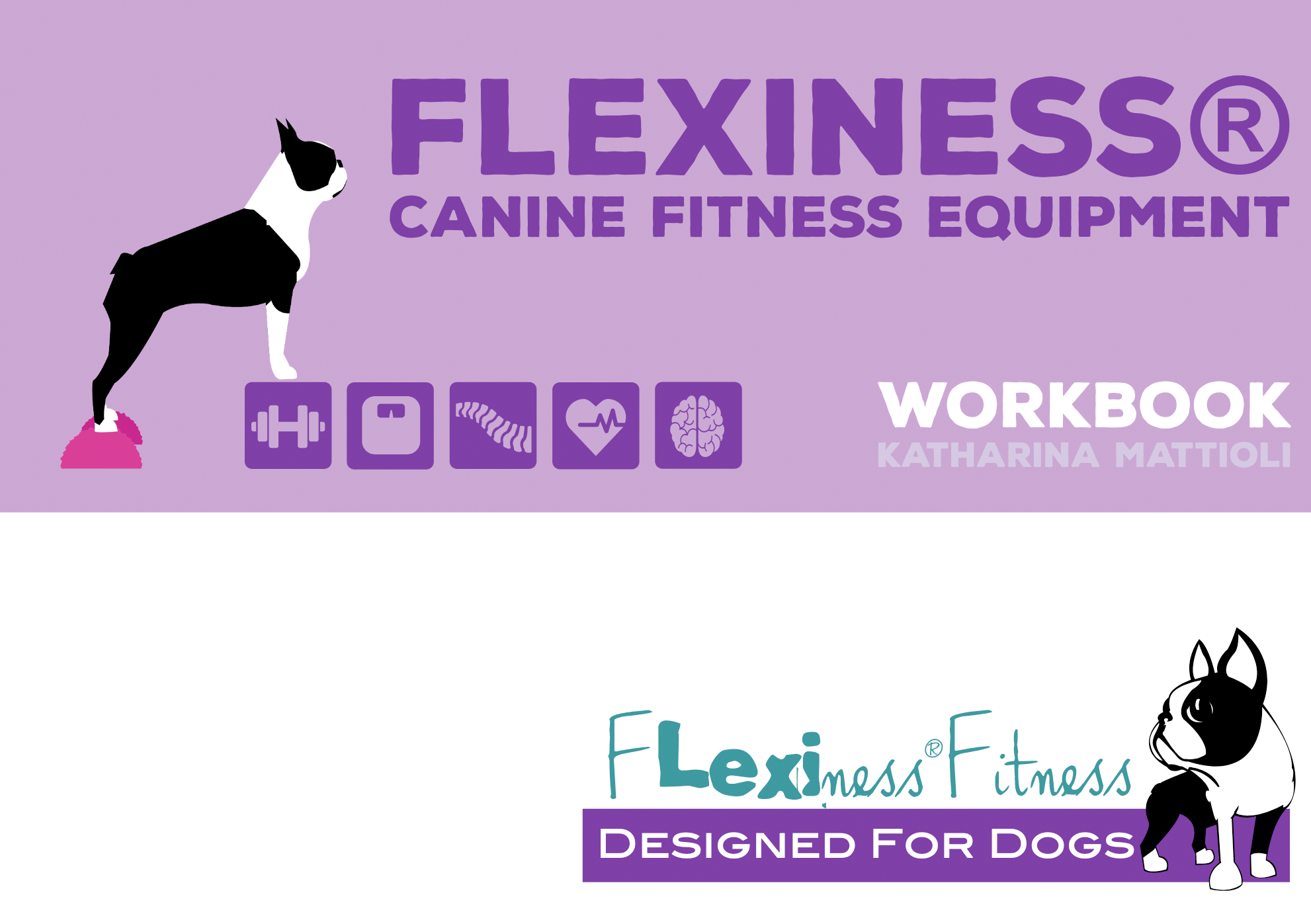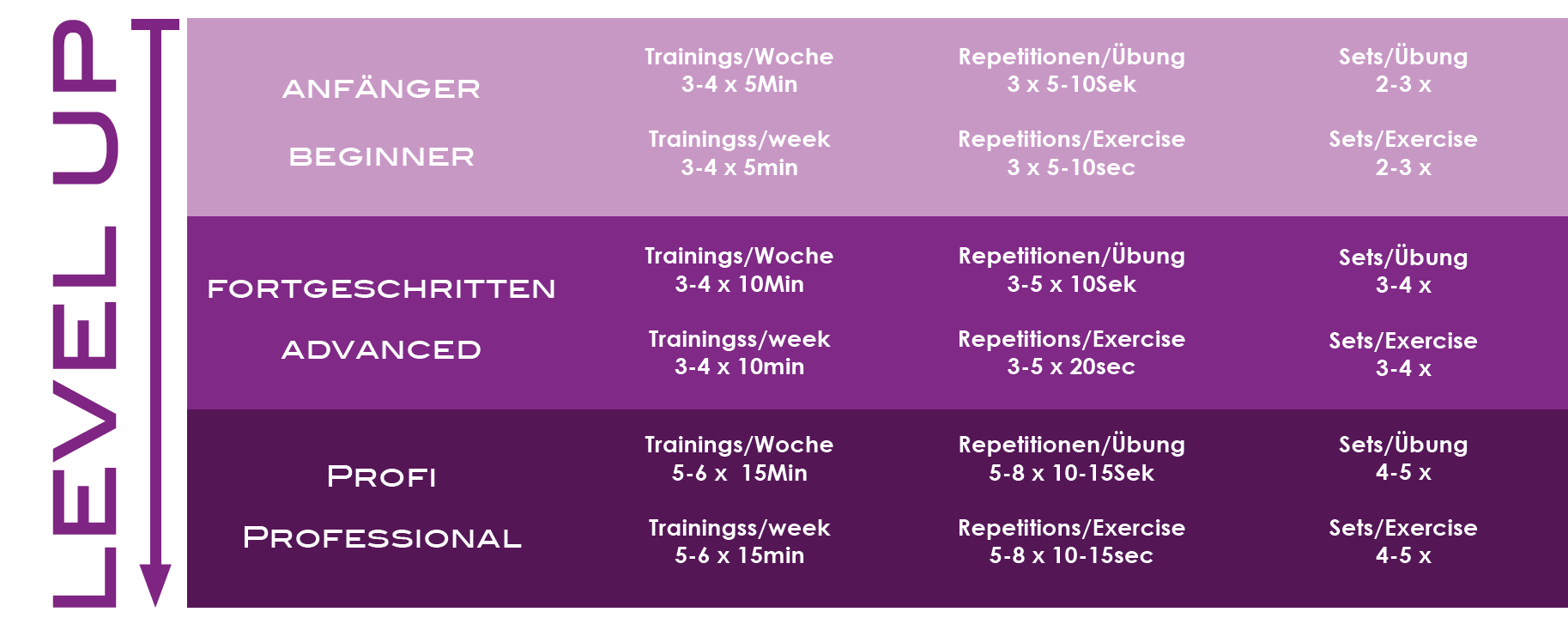All the essential information about the new Flexiness® equipment
Tips & videos for the first training sessions
10-15 minutes a day!
They positively influence a dog’s life and increase the well-being. Start slowly and adjust duration, repetitions and sets later. Hold positions for 5-10 seconds and repeat 3-5 times per set. Don’t forget to warm up!
Form/posture
The question of form/posture should be asked again and again. It is important to look at the dog in a neutral position on the ground. Check in different positions (standing, sitting and down) and from all 4 sides (front, back, both sides).
Particular attention should be paid to the following:
– Head position
– Placement of the paws (straight, turned in or out)
– Backline alignment
– Angles (front and hind limbs)
– Limb positioning (underneath the body, splayed out…)
On the product it is important to ensure that the dog has a good posture. The dog should stand as ‘natural’ as possible. Means: the top line is straight and the neck is not overstretched. Of course, there are exercises that deviate from this form. However, these exercises require a separate introduction.
Age:
When planning training, always consider the dog’s age and fitness level.
For young dogs (up to 12 months) and seniors, an introduction by a trainer is highly recommended.
For young dogs (under 12 months):
Focus on practicing the basics!
Keep training sessions short!
Avoid repetitive position or posture changes (Exercises 4-6) on the equipment!
How do I inflate the devices?
The Flexiness® devices can be inflated with a standard ball or bicycle pump. With caution you can also use a compressor. For reasons of sustainability, we intentionally refrain from supplying a pump with every device.
Please note that the amount of air in the devices has an influence on training. The firmer the equipment and the lighter the dog, the lower the resistance and, consequently, the lesser the training effect. It should also be noted that most devices become less stable with more air. When adjusting the amount of air, the age and fitness level of the dog must always be taken into account. If in doubt, contact your veterinarian or therapist.
As already described at the beginning, we do not supply pumps or attachments with the products for reasons of sustainability. If a suitable attachment for your bicycle pump or compressor is not readily available, we’re happy to help!
Which device requires which attachment?
Flexiness® Donuts, Peanuts, TwinDisc, PawDisc, Cloud
These devices do not have a valve and only require an attachment that fits into the opening.
2. Flexiness® PawStackers, ToyPawStackers, StackingBars, DonutDisc (available from us)
These devices require a needle attachment. To regulate air in the devices, simply insert the attachment into the valve without a pump. By pressing on the device, air escapes through the opening of the attachment.
3. Flexiness®FitStages (available from us)

Size Donuts/Peanuts?
After the devices have been inflated for the first time, please pump them again after approx. 2-3 days so that they can develop their full size. The final size of the Peanuts & Donuts* is typically reached only a few weeks after the initial inflation. The amount of air also determines the size of the donut/peanut. It may happen that a device is not 100% horizontal due to production reasons. However, the slight slope has no influence on the quality of the device or training. You can even see this as an extra challenge.
* The sizes given are guidelines, depending on the amount of air, this can vary greatly.
How can I clean the devices?
The devices can be easily cleaned with diluted soapy water or glass cleaner. For hygiene reasons, we recommend doing this regularly. This also makes the surface more grippy again and greatly reduces the possibility of slipping.
Attention:
If the devices:
- are cleaned with harsh cleaners,
- combined with other products (not from Flexiness®),
- used with holders,
- are exposed to strong sunlight,
we do not take responsibility for any potential damage.
Lifespan?
The lifespan of the devices is determined by how they are handled and how intensively they are used. To avoid damage, the devices should no be stored near a heat source. It should also be noted that warm air expands. The inflatable devices* are not bite-proof. Please pay attention to good nail care, pointy and/or sharp nails can damage the inflatable device. Pointed or sharp objects can damage the device – pay attention to the condition of the floor.
Attention:
If the devices:
- are cleaned with harsh cleaners,
- combined with other products (not from Flexiness®),
- used with holders,
- are exposed to strong sunlight,
we do not take responsibility for any potential damage.
* especially Donuts
Maximum load on the devices?
The maximum load on the devices is 150kg (even). FlexBox 100 kg
Guarantee?
As a producer, Gangwerk GmbH guarantees the buyer that this product is free from manufacturing defects* for a period of 30 days from the invoice date. If your product shows signs of defective manufacturing during this period, please contact us immediately.
* Slight production-related deviations in shape and color are not considered errors.
Attention:
If the devices:
- are cleaned with harsh cleaners,
- combined with other products (not from Flexiness®),
- used with holders,
- are exposed to strong sunlight,
we do not take responsibility for any potential damage.
Training?
To prevent slipping and sliding, always train on a non-slip surface. For beginners, it’s advisable to start with ground-level equipment. Don’t forget to warm up your dog for about 5 minutes at a relaxed trot before each training session.
The Flexiness® devices are not toys but training tools. NEVER leave the dog unsecured or unsupervised and put away the equipment after training.
Flexiness®FitStage 1x1
The lid above the valve must be opened by turning it to the left. Then screw the adapter or pump attachment into the valve (to the right). Before screwing it in, ensure that the small, centrally placed button in the valve is always set to ‘open’. If it is pushed in, the device cannot be inflated because the air keeps escaping as soon as the pump or adapter is removed.
Please always inflate the Flexiness®FitStage completely (no wrinkles!) to avoid damage to the product. The small button in the valve allows the amount of air to be regulated very well with small, short pressure bursts.
If you ever get a hole in the FitStage due to external influences, the FitStage can be repaired with appropriate repair material (for SUPs, boats, etc.). We’re happy to help. Simply water or diluted dish soap is suitable for cleaning. We recommend our Flexiness®SensiMats and SensiTargets as supports.

Basic Exercises
The following exercises can be done with all dogs*. Anfänger bis Fortgeschrittene, Junghund bis Senior. Die Tabelle soll helfen das Training effektiv und dem Zustand des Hundes entsprechend zu gestalten.
The exercises shown below can be done with different combinations of equipment. The devices should be selected based on the dog’s age, training condition and size.
* sofern keine Diagnose vorliegt die das aktive Training einschränkt.
2 UP FRONT
Goal:
The dog places its front paws on the device.
Attention:
Donut or Peanut? Be sure to secure the device with your hand and/or legs to stabilize it.
Procedure:
Guide the dog towards the device by luring with food, hand signals, or a hand target, and encourage them to place their front paws on the device. Hold position 5-10 seconds.
Tips:
– Position yourself directly in front of the dog.
– Use a marker (e.g., ‘Up’).
– Weight shifts intensify the training.
– Pay attention to proper body posture.
2 UP REAR
Goal:
The dog places its hind paws on the device.
Important:
Pay attention to the backline, head position, and limb alignment! Shifting weight intensifies the training.
Procedure:
Guide the dog towards the device by luring with food, hand signals, or a hand target, and encourage them to place their front paws on the device (Exercise 1). Let the dog stand for a few seconds, then try to have the dog move forward so that the front limbs return to the ground while the hind limbs remain on the device.
Progression:
The dog moves backward onto the device.
PAWS UP
Starting positions (3 variations):
The dog stands with its front paws on the device.
The dog stands with its hind paws on the device.
The dog stands with all four paws on the device.
Exercise:
The dog should stand still.
Lift one paw and hold it for 5-10 seconds, then place the paw back down. Repeat this with all four paws (even if they are not on the device!).
Pay attention to the weight shift and how the dog balances itself.
Progression:
The dog lifts its paws on its own (e.g., waving, paw target…).
STAND
Starting position:
The dog moves forward, first onto the first device and then onto the second. The hind limbs are then placed on the first device. The larger the target area (device), especially for the hind limbs, the easier this exercise will be for the dog.
Exercise:
Hold the position for a few seconds (see table).
In this exercise, ensure that the dog stands as parallel as possible, with a straight backline and the head in a neutral position.
Progression:
The dog moves backward onto the devices.
PawsUp
TRANSITIONS
Starting position:
The dog stands with its front paws on the device.
Exercise:
The dog moves forward with its front paws on the ground and hind limbs on the device.
Then, the dog moves backward until the front paws are back on the device and the hind limbs are on the ground.
Positions can be held for a few seconds, or the exercise can be performed fluidly.
Progression:
Incorporate BackUp and PawUp.
Personalized support?
Private lessons via Zoom or at the Flexiness® K9 Studio in Lengau AG.
- Handling 1×1: ‘How do I teach this to my dog?’
- Fitness Lesson: ‘I want more…’
- Individual Training Plan
- Individual Equipment Consultation

